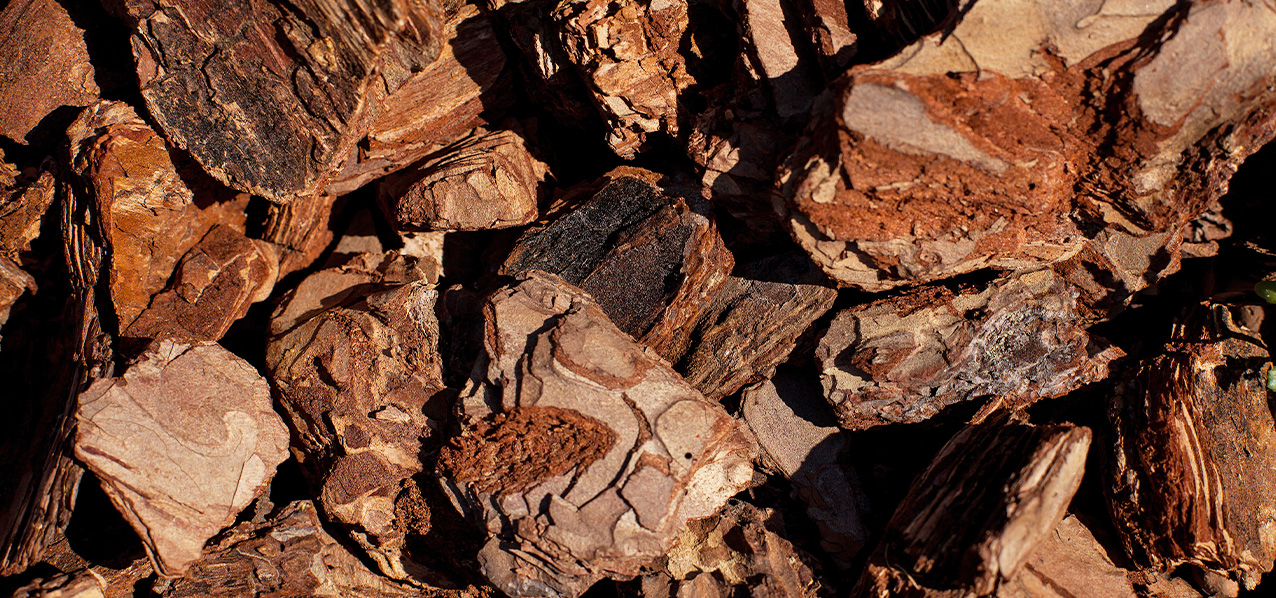Quality criteria for bark products
Bark mulch for landscape gardening
Bark mulch
Requirements and recommendations for the use of bark mulch
Bark mulch for landscape gardening
The wood-processing industry and tradespeople usually only use trunks from which the bark has been stripped. However, the stripped-off raw bark is renewable feedstock of high ecological value for landscape gardening. It is collected, shredded in humus and soil operations, sifted and later fermented. This is how bark mulch and bark humus are made – from nature for nature and the garden!
Bark mulch
Bark mulch is used as organic ground cover in landscape gardening and is ideal for this purpose. Because just as bark protects deciduous and evergreen trees from all kinds of factors, bark mulch protects the planted soil.
Requirements and recommendations for the use of bark mulch
Apply a layer, about 5-7 cm thick, of RAL-certified bark mulch on a largely weed-free surface. Apply horn meal (40-80 g/m²) around shallow rooted plants (such as perennials) before mulching to ensure adequate nitrogen supply. Leave a distance of 5 cm from the trunks of young trees.
Advantages of bark mulch:
- reduced water consumption due to lower irrigation requirements
- fewer weeds, as weed growth is suppressed
- makes gardening easier
- more uniform soil moisture levels
- better protection from drying out
- reduced exposure to heat and cold
- increased activation of soil biology
- improved mineral supply to plants
In other words, enjoy your attractive garden. The uniform brown mulched surface looks neat and clean and reduces the time required for gardening
Bark humus for landscape gardening
Bark humus is made from fine bark that is subjected to a controlled rotting process for a long period of time. Bark humus is a valuable source of humus and nutrients that improve the soil.
Requirements and recommendations when using bark humus:
Apply a layer, 0.5 – 1.0 cm thick, of RAL-certified bark humus in early spring or at some point during the growing season and work it into the top soil. When planting trees or shrubs, add up to 30 vol. % of bark humus to the planting media and mix well.
Formation processes of bark products on quality criteria

Advantages of bark humus:
- improved soil fertility
- improved supply of water, air and heat
- stronger plant growth
Download for quality criteria
Quality criteria for bark products
Bark mulch for landscape gardening
Bark mulch
Requirements and recommendations for the use of bark mulch
Bark mulch for landscape gardening
The wood-processing industry and tradespeople usually only use trunks from which the bark has been stripped. However, the stripped-off raw bark is renewable feedstock of high ecological value for landscape gardening. It is collected, shredded in humus and soil operations, sifted and later fermented. This is how bark mulch and bark humus are made – from nature for nature and the garden!
Bark mulch
Bark mulch is used as organic ground cover in landscape gardening and is ideal for this purpose. Because just as bark protects deciduous and evergreen trees from all kinds of factors, bark mulch protects the planted soil.
Requirements and recommendations for the use of bark mulch
Apply a layer, about 5-7 cm thick, of RAL-certified bark mulch on a largely weed-free surface. Apply horn meal (40-80 g/m²) around shallow rooted plants (such as perennials) before mulching to ensure adequate nitrogen supply. Leave a distance of 5 cm from the trunks of young trees.
Advantages of bark mulch:
- reduced water consumption due to lower irrigation requirements
- fewer weeds, as weed growth is suppressed
- makes gardening easier
- more uniform soil moisture levels
- better protection from drying out
- reduced exposure to heat and cold
- increased activation of soil biology
- improved mineral supply to plants
In other words, enjoy your attractive garden. The uniform brown mulched surface looks neat and clean and reduces the time required for gardening
Bark humus for landscape gardening
Bark humus is made from fine bark that is subjected to a controlled rotting process for a long period of time. Bark humus is a valuable source of humus and nutrients that improve the soil.
Requirements and recommendations when using bark humus:
Apply a layer, 0.5 – 1.0 cm thick, of RAL-certified bark humus in early spring or at some point during the growing season and work it into the top soil. When planting trees or shrubs, add up to 30 vol. % of bark humus to the planting media and mix well.
Formation processes of bark products on quality criteria

Advantages of bark humus:
- improved soil fertility
- improved supply of water, air and heat
- stronger plant growth




